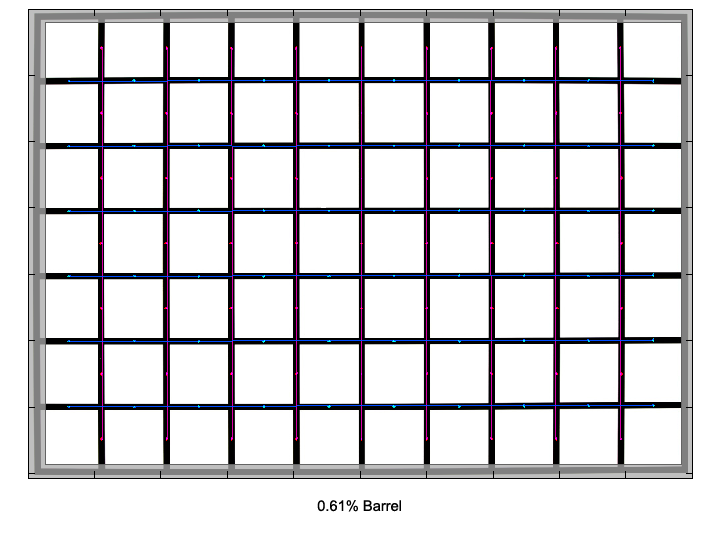|
Page 2 of 2

Distortion
Distortion is farily moderate on DX cameras and usually nothing to worry about in the field. There is a small amount of barrel distortion at 70mm, switching over to pincushion distortion at longer focal lengths.
|
Move the mouse cursor over the focal length text marks below to observe the respective distortion
|
| 70mm |
135mm |
200mm |
|

|
The chart above has a real-world size of about 120x80cm.
Vignetting
Since the Sigma is designed for full-frame sensor, it beneftis from the sweet-spot advantage on DX cameras. Thus, vignetting is well under control. At the largest aperture setting, it may be visible with critical subjects, but nothing to worry about stopped down to f/4 and beyond.

MTF (resolution)
At both ends of the zoom range, the lens delivers very good resolution wide open in the image center, which increases to excellent sharpness when stopped down. At 135mm, the resolution is already excellent at the largest aperture setting.
At 70mm the borders show very good resolution wide open and even increase to excellent figures at f/5.6. The image corners follow only slightly behind, with very good sharpness at all tested apertures. The performance peak across the frame is reached at f/5.6 here.
At 135mm, the borders and corners start out a little lower, but recover to very good resolution when stopped down.
At the longest focal length setting, the borders and corners show significantly less resolution at large apertures. Wide open, the results are just fair here. Both regions recover by stopping down, but the lens needs to be set to f/8 to reach very good resolution here.
At the long end of the zoom range, the lens shows a small amount of focus shift when stopping down (residual spherical aberration).
Please note that the MTF results are not directly comparable across the different systems!
Below is a simplified summary of the formal findings. The chart shows line widths per picture height (LW/PH) which can be taken as a measure for sharpness.
If you want to know more about the MTF50 figures you may check out the corresponding Imatest Explanations

Chromatic Aberrations (CAs)
Chromatic aberrations (color shadows at harsh contrast transitions) are well controlled at the largest aperture setting. At medium and long focal lengths, CAs increase by stopping down, however. The largest amount of CAs is visible at 135mm stopped down beyond f/8 with an amount of just above 1.5 pixels at the image borders.
Please note that lateral CAs can easily be corrected in software or by the camera itself (most modern Nikon DSLRs remove CAs on-the-fly if you shoot JPGs).

Bokeh
Being a fast tele lens one of the lens' welcome abilities is to separate the main subject from the background, so rendering of out of focus areas is an important aspect.
The EX 70-200 OS delivers a generally very smooth bokeh at all focal lengths.
Thanks to 9 rounded aperture blades, background highlights remain circular throughout the whole aperture and focal range, except at the image borders where they are cut off due to mechanical vignetting. They show a smooth filling with almost no outlining.

Bokeh Fringing
Bokeh fringing is a common issue with relatively fast glass. It's visible as halos of different colors in out-of-focus areas - magenta (red + blue) in front of the focus point
and green beyond.
The EX 70-200/2.8 OS is an APO lens. Consequently, there is only a very small amount of bokeh fringing wide open, which is completely gone by f/4 and beyond.
The images below, shot at 200mm, illustrate the focus shift when stopping down, as mentioned in the MTF section.
Sample Images
You can find some sample images taken with the Nikon D3x in our Nikon FX review of the lens.
VerdictThe Sigma AF 70-200mm f/2.8 EX OS HSM delivers very good to excellent sharpness at the image center and mostly very good sharpness across the frame throughout most of the focal range. At the longest focal length, however, the results at the image borders and corners are disappointing at large aperture settings.
On DX cameras, vignetting and distortion are well under control and no issues in the field. CAs are minor wide open and moderate when stopped down. The bokeh is very smooth and being an APO lens there is almost no bokeh fringing.
The build quality of the lens is excellent. Thanks to a HSM drive the autofocus operates very fast and silent. The optical stabilizer allows for up to 3 stops longer shutter speeds in the field and subjectively performs in the same level as Canon's IS and Nikon's VR II implementations.
Compared to the "big boys", Canon's and Nikon's reference zoom lenses, the Sigma performs on a similar level in many regards, but clearly lacks sharpness at the image borders at the long end of the zoom range. In addition, it also shows pronounced focus breathing, which means the focal length is reduced considerably at close focus distances (however, this is also true for the current Nikon 70-200/2.8 VR II lens). If the lack of border resolution is not an issue, the Sigma lens offers a nice high-end package for significantly less money.
|